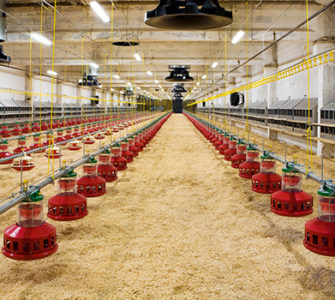Ruling the roost: Alternative or conventional chicken?
By Philip A. Stayer, DVM, MS, ACPV
Corporate Veterinarian
Sanderson Farms, Inc.
A recent summer collegiate intern — who happens to be my daughter, Sumner — conducted a small study comparing whole-bird fryers from three different types of production systems:
- Conventional production and diet, which were Sanderson Farms tray-pack chickens
- Organic/RWA — Traditional production with organic and/or raised without antibiotic (RWA) systems purchased from a local retailer
- Pastured — Pastured production with organic and/or RWA systems that she purchased already processed from a nearby hobby farmer
Sumner is interested in human nutrition. For this study, she wanted to explore the relationship between these three different poultry-production types and consumer-based attributes.
Her study included four parts. She evaluated food safety by checking for microbial loads, and she determined nutritional components. She also evaluated taste with a focus on characteristics rather than preferences, and, finally, she explored the thinking of consumers behind their decision to purchase a particular poultry product.
Testing results
The presence of bacteria was determined by whole-bird carcass rinses. With the help of Sanderson’s microbiology laboratory, Sumner found higher total bacterial loads on the pastured poultry compared to chicken from the other two groups.
Grow-out conditions were confounded by processing procedures. Both conventional and organic/RWA chickens were processed in USDA-inspected facilities whereas the pastured-poultry chickens were dressed by hand in an open-air shed.
It was easy to see during our visit to the hobby farmer’s home/farm how bacteria could proliferate in an uncontrolled outside environment in hot, humid south Mississippi, although thorough cooking would most likely yield the same wholesome meat for consumption.
After the microbial sampling and rinsing with tap water, Sumner had deboned, skinless raw meat from the whole carcasses tested at Sanderson’s chemistry lab for protein, moisture, minerals and fat content. Breast meat was analyzed separately from thigh meat.
The lab found that breast meat did not differ among the groups. Leg meat from conventional birds appeared to have similar protein, moisture and minerals but was higher in fat than the other two production systems.
This is conjecture, but maybe providing protection from environmental extremes as well as utilizing modern medicines allows the animal to have a more positive energy balance than alternative production systems. Because fat adds flavor, a higher fat content may be preferred by consumers looking for a more robust taste.
Tasting panel
It’s important to note that the eight tasting-panel members were readily available Sanderson Farms employees — not trained tasting professionals. The meat was cut up and baked to a temperature safe for consumption. Granted, it wasn’t seasoned to avoid altering flavors, so the taste-test results may not be as discriminating as some palates may discern.
In brief, all the meat tasted like chicken, whether it was white or dark meat and despite the production systems. There were no meaningful differences in appearance, juiciness, texture or flavor.
There was a slight preference for thigh meat from the conventional chickens, presumably due to the higher fat content. Apparently, the bacterial overgrowth found in the pastured poultry was cooked out.
Purchasing decisions
Sumner interviewed two select pools of consumers: four purchasers of conventional chicken and four faithful purchasers of chicken provided by the pastured-poultry producer.
She asked quite a few questions about their choices, including why they chose a particular type of chicken; how cost figures in; and if they consider freshness, food safety, taste and ease of purchase. She also asked whether their purchasing decisions were affected by considerations for health benefits, animal welfare and the ecological impact of various poultry-production systems.
She found the answers were similar to a report from the 2017 National Chicken Marketing Summit held in Asheville, North Carolina.1 Traditional chicken consumers ranked price, freshness and taste as the top three priorities when they purchased poultry.
The non-traditional buyers of pastured poultry placed distrust of large processors and their marketing campaigns as their primary reason for avoiding traditionally raised chicken products. This crowd said price was not even a factor to consider and that perceived health benefits were of utmost importance. The non-traditional consumers were confident in their personal choice even though they acknowledged this type of production had limited sustainability, i.e., pastured poultry can’t feed the world.
Pre-formed opinions
Although Sumner’s study was limited in time, geography and size, her findings also agreed with previously published reports. Non-traditional processing, for instance, has been linked to increased bacterial loads.2
There was no difference in protein content among chicken raised in conventional versus unconventional production systems, and US consumers cannot differentiate the taste of meat from varied rearing practices.
Sumner concluded that consumer selection of poultry was less about actual product comparison and more about pre-formed opinions and habits.
Implications for industry
In the US, industry data indicate that although the percentage of broilers raised without antibiotics continues to escalate, only a fraction of that chicken meat is sold as such. Great Britain’s poultry producers have already experienced an over-supply and under-purchase of “slow-grow” chickens that tend to be raised in pastured-poultry systems.3
As long as choices in rearing conditions do not adversely affect animal well-being, production practices should vary as much as consumers’ demand to accommodate the basic economic law of supply and demand in a free-market economy.
On the other hand, it seems apparent to me that many trends come and go, which might apply to chicken production as well. The first supplier to fill whatever niche is found obviously reaps the greatest reward. The second and third sources always face diminishing returns.
As long as at least some members of society struggle to feed themselves, the most efficient animal-protein source will have a place in the meat market. I predict the most economically produced chicken will rule the roost while alternative products will quickly oversupply their respective niches.
Editor’s note: The opinions and advice presented in this article belong to the author and, as such, are presented here as points of view, not specific recommendations by Poultry Health Today.
1. US Chicken Consumption. Presentation to Chicken Marketing Summit. July 18, 2017, Asheville, NC.
2. Dirty Birds: Does Pastured Poultry Mean More Pathogens? Modern Farmer, 2013 July 24. http://modernfarmer.com/2013/07/poultry-pathogens/ Accessed September 4, 2017.
3. Personal communication with a poultry research and development company.
Posted on December 5, 2017

















